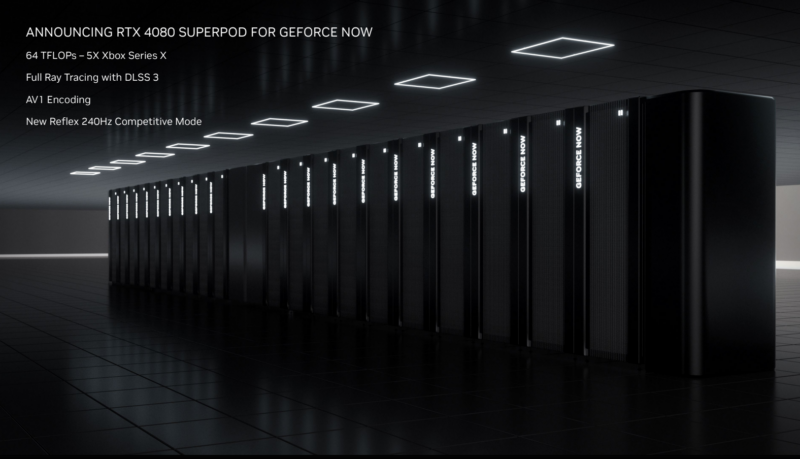
Cloud-based gaming service GeForce Now’s new Ultimate tier is rolling out today, promising a series of adjectives about game streaming that might have seemed impossible just a few years ago: high-resolution, ray-traced, AI-upscaled, low-latency, high-refresh-rate, and even competition-ready.
I tested out the Ultimate tier, powered by Nvidia’s RTX 4080 “SuperPODs,“ for a week on a server set up for reviewer early access. If I hadn’t been hyper-conscious of frame numbers and hiccups, I could have been tricked into thinking the remote 4080 rig was local. Ultimate streaming can also be “better than local,” such as when it lets you stream a AAA, ray-traced game on a low-powered laptop, tablet, or TV with no console attached.
Ars had previously described our GeForce Now 3080 experience as “dreamy” and called the performance “a white-hot stunner that rivals the computing power you can muster” with the same RTX 3080 card in your PC. It’s easy to lay at least the same kind of praise on the new Ultimate tier. It replaces the previous RTX 3080 option with the next generation’s chipset for the same price ($20 per month, $99 for six months). That might be a steep price tag for a service that mostly makes you buy your games, but given the 4080’s $1,200 price, the rent-versus-buy question is worth considering at this level.
That’s especially true if you want the flexibility to bring your games to screens outside your main gaming system. I got to play Hitman 3 on a MacBook Air (through a monitor) at rates higher than 60 frames per second, at medium-to-high graphics. I logged a few impressive-looking battles in Marvel’s Midnight Suns, sitting on a couch with an iPad and a Nintendo Switch Pro Controller. I almost felt bad when Cyberpunk 2077 on an Nvidia Shield benchmarked 90 fps at 4K on my 60 Hz TV (save those extra frames for lean times!). When playing on these lower-res or lower-refresh screens, an Ultimate stream trades impressive fidelity for stability.
Not everybody has the high-refresh monitor, or the interest in GeForce Now’s particular games library, to need the Ultimate tier. But if you have wider bandwidth on your Internet connection than in budgeting for a single piece of a gaming PC, or want to test the waters of max-spec PC gaming, GeForce Now Ultimate is mighty intriguing.
Test-driving a monster GPU across the Northeast
What follows is a first impression of the service, more like a test drive than a full review covering every facet. That’s for a few reasons. My monitor’s refresh rate only (“only”) goes to 144 Hz (i.e., 144 fps). I tend toward single-player games, not twitchy multiplayer shooters. I didn’t dig much into Reflex mode, the latency-reducing setting aimed at competitive games like Apex Legends, Rainbow Six Siege, Destiny 2, and others (The Verge review leans into that aspect heavily). My personal graphics card is an RTX 3050, a budget-minded model that couldn’t hope to hit 60 fps at 1440p on ultra or max settings on our test games.
In other words, I’m a PC gaming enthusiast living with a pedestrian mix of hardware—potentially just the type GeForce Now is targeting.
Still, I had some basis for comparison. I previously had a Founders Edition account that provided access to less-powerful card types (GTX 1080 and, on occasion, GTX 2060) and was familiar with the games’ performance on my local RTX 3050. I mostly stuck to games in my library that worked on GeForce Now, though I briefly dipped into Destiny 2 multiplayer to see how remote multiplayer felt. And I’ve been a regular user of Nvidia’s local-streaming GameStream, with the lowest latency you could hope for.
-
GeForce Now’s latest server location and international partners.Nvidia
-
The Ultimate 4080 membership promises to be a big upgrade for those already subscribed to 3080—especially, for some reason, for Warhammer fans.Nvidia
-
Games supporting DLSS especially come out on top with the 4080 membership, something I can testify to.Nvidia
-
If you’re more about that speed and latency than looks, Reflex Mode offers some intriguing technology for whittling down the click-to-photon latency.Nvidia
